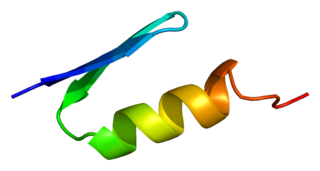
Oct-4, also known as POU5F1, is a protein that in humans is encoded by the POU5F1 gene. Oct-4 is a homeodomain transcription factor of the POU family. It is critically involved in the self-renewal of undifferentiated embryonic stem cells. As such, it is frequently used as a marker for undifferentiated cells. Oct-4 expression must be closely regulated; too much or too little will cause differentiation of the cells.

Homeobox protein NANOG(hNanog) is a transcriptional factor that helps embryonic stem cells (ESCs) maintain pluripotency by suppressing cell determination factors. hNanog is encoded in humans by the NANOG gene. Several types of cancer are associated with NANOG.
In biology, reprogramming refers to erasure and remodeling of epigenetic marks, such as DNA methylation, during mammalian development or in cell culture. Such control is also often associated with alternative covalent modifications of histones.

Growth differentiation factor-3 (GDF3), also known as Vg-related gene 2 (Vgr-2) is protein that in humans is encoded by the GDF3 gene. GDF3 belongs to the transforming growth factor beta (TGF-β) superfamily. It has high similarity to other TGF-β superfamily members including Vg1 and GDF1.

SRY -box 2, also known as SOX2, is a transcription factor that is essential for maintaining self-renewal, or pluripotency, of undifferentiated embryonic stem cells. Sox2 has a critical role in maintenance of embryonic and neural stem cells.

E3 ubiquitin-protein ligase CHFR is an enzyme that in humans is encoded by the CHFR gene.

HIV Tat-specific factor 1 is a protein that in humans is encoded by the HTATSF1 gene.

Prion protein 2 (dublet), also known as PRND, or Doppel protein, is a protein which in humans is encoded by the PRND gene.

DNA (cytosine-5)-methyltransferase 3-like is an enzyme that in humans is encoded by the DNMT3L gene.

60S ribosomal protein L10a is a protein that in humans is encoded by the RPL10A gene.

Doublesex and mab-3 related transcription factor 1, also known as DMRT1, is a protein which in humans is encoded by the DMRT1 gene.

Homeobox protein Hox-D1 is a protein that in humans is encoded by the HOXD1 gene.

Centriolin is a protein that in humans is encoded by the CNTRL gene. It was previously known as CEP110.

Histone-lysine N-methyltransferase EZH1 is an enzyme that in humans is encoded by the EZH1 gene.

Sperm-associated antigen 8 is a protein that in humans is encoded by the SPAG8 gene.

Zinc finger X-chromosomal protein is a protein that in mammals is encoded by the ZFX gene of the X chromosome.

Protocadherin alpha-12 is a protein that in humans is encoded by the PCDHA12 gene.

Glypican-5 is a protein that in humans is encoded by the GPC5 gene.

Rex1 (Zfp-42) is a known marker of pluripotency, and is usually found in undifferentiated embryonic stem cells. In addition to being a marker for pluripotency, its regulation is also critical in maintaining a pluripotent state. As the cells begin to differentiate, Rex1 is severely and abruptly downregulated.

Cytochrome P450 26B1 is a protein that in humans is encoded by the CYP26B1 gene.

















